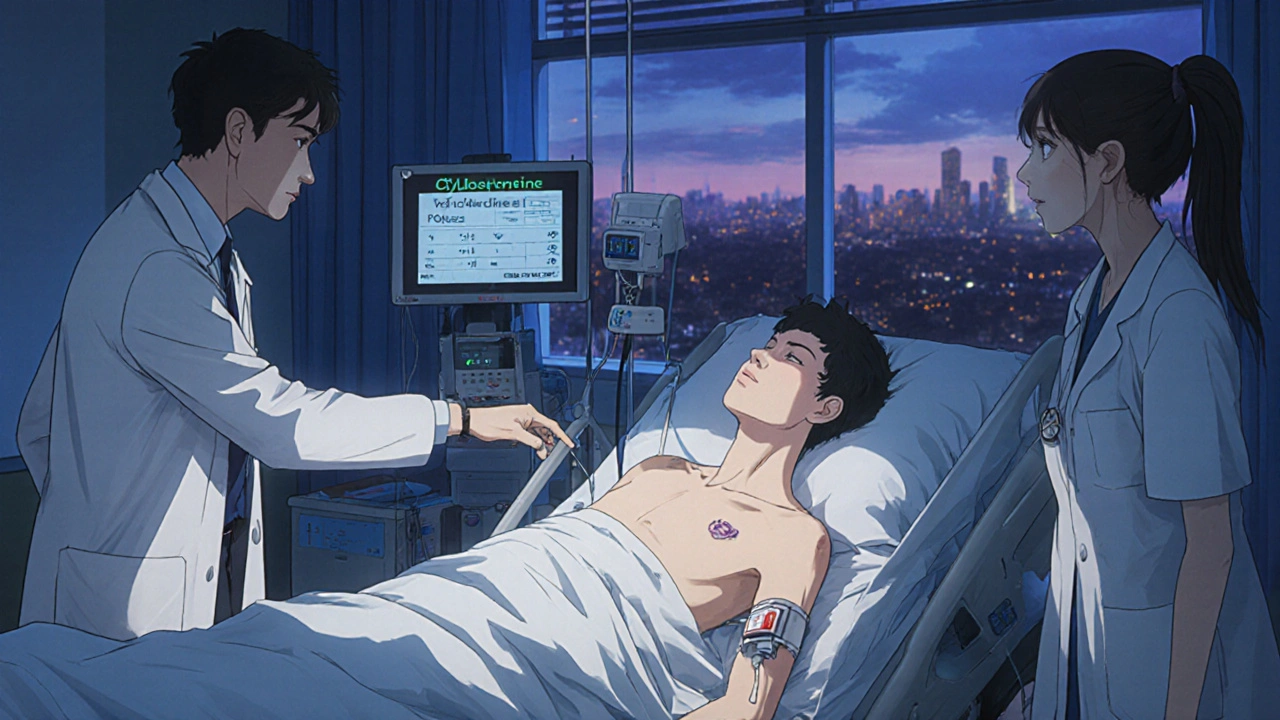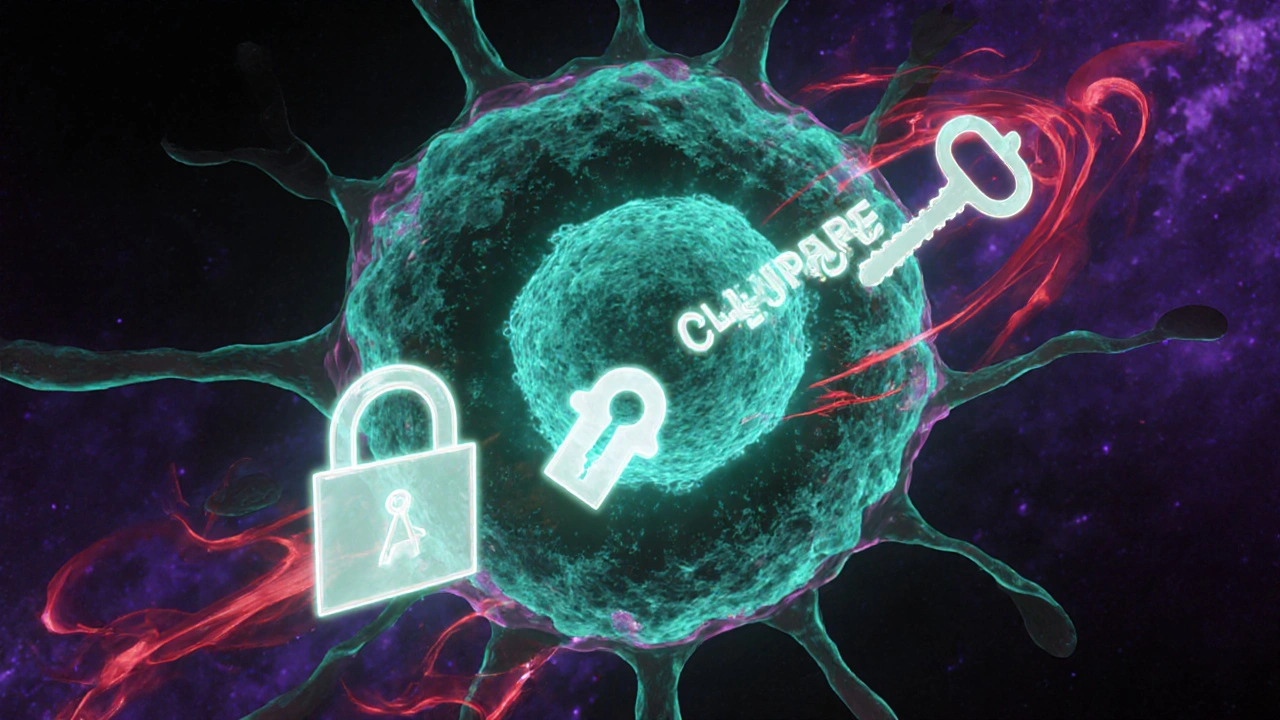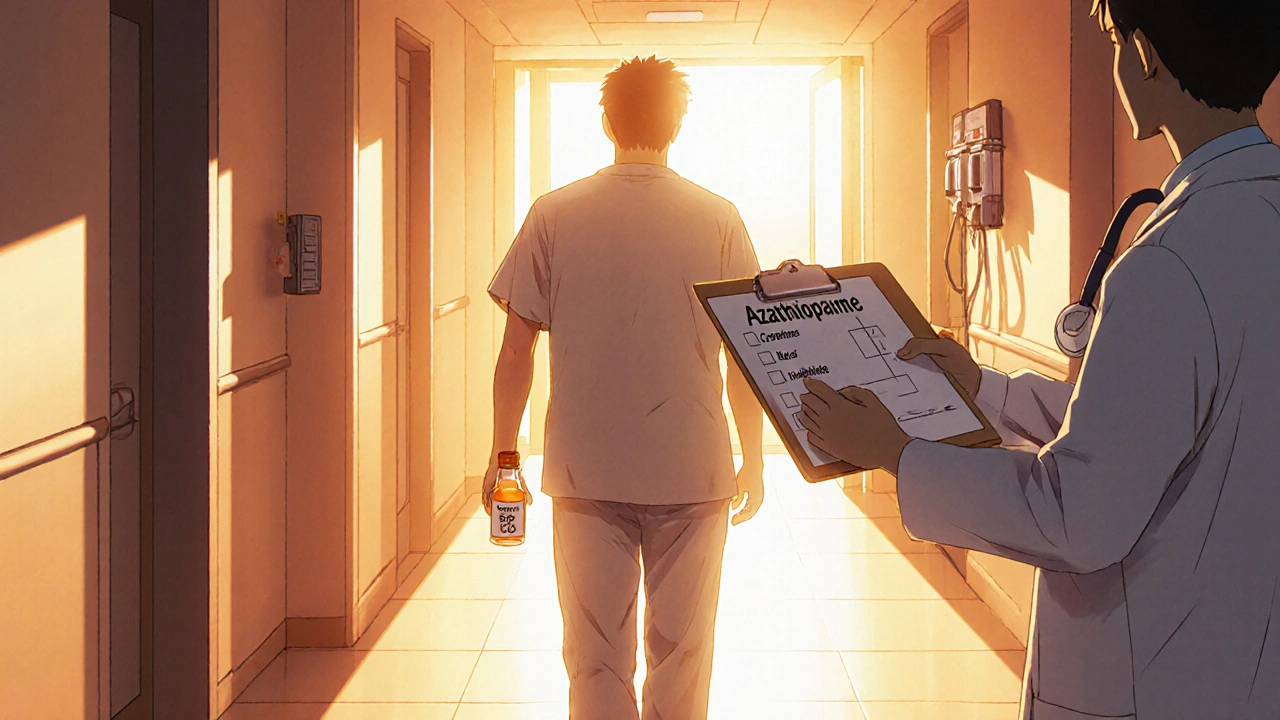Cyclosporine for Inflammatory Bowel Disease: Is It a Game‑Changer?
 Oct, 17 2025
Oct, 17 2025
Cyclosporine Dosing Calculator
Cyclosporine Dosing Calculator
Calculate appropriate IV and oral dosing for acute severe ulcerative colitis based on patient weight and renal function.
Calculated Dosing:
Cyclosporine has been a staple in transplant medicine for decades, but its role in inflammatory bowel disease (IBD) remains a hot debate. This article walks you through what the drug does, how it stacks up against other IBD options, and what the latest research says about safety and effectiveness.
Quick Takeaways
- Cyclosporine works by blocking calcineurin, a key step in T‑cell activation.
- It is most often used for acute severe ulcerative colitis when steroids fail.
- Clinical trials show rapid remission rates (50‑70% within 7‑10 days) but relapse is common after stopping the drug.
- Nephrotoxicity, hypertension, and infections are the main safety concerns.
- Therapeutic drug monitoring and a short‑term bridge to maintenance therapy (e.g., azathioprine) are essential for safe use.
What Is Inflammatory Bowel Disease?
IBD is an umbrella term for chronic inflammation of the gastrointestinal tract. The two main forms are Crohn's disease, which can affect any part of the GI tract and often involves transmural inflammation, and ulcerative colitis, which is limited to the colon and presents with continuous mucosal ulceration.
Patients experience abdominal pain, bloody diarrhea, weight loss, and fatigue. The disease course is unpredictable, with periods of remission punctuated by flares that may require hospitalization.
Cyclosporine: A Brief Overview
Cyclosporine is a cyclic polypeptide originally isolated from Trichoderma polysporum. It is best known as a calcineurin inhibitor, meaning it blocks the phosphatase that activates NFAT (nuclear factor of activated T‑cells), thereby suppressing T‑cell mediated immune responses. While its primary indication is preventing organ transplant rejection, rheumatologists and gastroenterologists have long explored off‑label uses, especially for severe, steroid‑refractory IBD.
How Cyclosporine Works in IBD
The inflammatory cascade in IBD is driven by an overactive immune system. Cytokines such as IL‑2, IFN‑γ, and TNF‑α perpetuate mucosal damage. By inhibiting calcineurin, cyclosporine reduces IL‑2 transcription, dampening T‑cell proliferation and cytokine release. This rapid immunosuppression can halt the inflammatory surge seen in acute severe ulcerative colitis (ASUC).
Because the drug acts upstream of many downstream cytokines, it can achieve remission faster than biologics that target a single molecule (e.g., infliximab targeting TNF‑α).
Evidence from Clinical Trials
Multiple randomized controlled trials (RCTs) have examined cyclosporine in ASUC. The landmark 1994 trial by Lichtiger etal. enrolled 115 patients who failed intravenous steroids. Intravenous cyclosporine (2mg/kg/day) induced clinical remission in 64% within 7days versus 23% for placebo.
A 2001 meta‑analysis of five RCTs reported pooled remission rates of 58% for cyclosporine versus 39% for rescue surgery, highlighting a clear short‑term benefit. However, relapse after discontinuation is high-up to 60% within six months-unless patients transition to an immunomodulator such as azathioprine.
More recent data (2022‑2024) suggest that combining cyclosporine with early anti‑TNF therapy may improve long‑term outcomes, but the evidence remains limited to small cohort studies.

Dosing, Administration, and Monitoring
Standard induction protocols use intravenous cyclosporine at 2mg/kg/day divided every 12hours for 3-5days, followed by oral tapering (typically 5mg/kg/day) over 2‑4weeks. Some centers prefer continuous infusion to maintain steady plasma levels.
Therapeutic drug monitoring (TDM) is crucial. Target trough concentrations range from 150-250ng/mL during induction. Levels above 300ng/mL increase the risk of nephrotoxicity without added efficacy.
Key labs to check before starting:
- Serum creatinine and eGFR (baseline kidney function)
- Blood pressure (cyc‑related hypertension)
- Complete blood count (CBC)
- Electrolytes, especially magnesium and potassium
During treatment, monitor creatinine daily (IV) and twice weekly (oral). Adjust dose promptly if creatinine rises >30% from baseline.
Benefits vs. Risks: A Practical Comparison
| Parameter | Cyclosporine | Corticosteroids (IV) | TNF‑α Inhibitors (e.g., Infliximab) |
|---|---|---|---|
| Onset of remission | 3-7days | 5-10days | 7-14days |
| Short‑term remission rate | 55‑70% | 30‑45% | 45‑60% |
| Need for colectomy (6weeks) | 10‑15% | 25‑30% | 15‑20% |
| Nephrotoxicity | 5‑15% | Rare | Rare |
| Infection risk | Moderate | Low‑moderate | Moderate‑high |
| Cost (US$ per course) | ~$2,500 | ~$1,200 | ~$9,000 |
Cyclosporine shines when rapid control is needed and surgery is looming. However, its renal side effects and the need for TDM make it less attractive for long‑term maintenance.
When to Consider Cyclosporine
Ideal candidates:
- Patients with acute severe ulcerative colitis (Mayo score ≥11) who have failed 3days of high‑dose IV steroids.
- Those who are unsuitable for immediate surgery due to comorbidities or personal preference.
- Individuals with normal baseline renal function and manageable blood pressure.
Contraindications include:
- Severe chronic kidney disease (eGFR <30mL/min/1.73m²).
- Uncontrolled hypertension.
- Active infections, especially CMV colitis.
Transitioning to Maintenance Therapy
Because cyclosporine’s effect wanes after 2‑4weeks, most gastroenterologists pair it with an immunomodulator. Common strategies:
- Start azathioprine or 6‑mercaptopurine simultaneously with cyclosporine induction.
- Maintain cyclosporine troughs for 7-10days, then taper oral doses while escalating the immunomodulator to therapeutic levels.
- Monitor thiopurine metabolite levels to avoid myelotoxicity.
Some centers now use methotrexate or even early anti‑TNF therapy as the bridge, but robust head‑to‑head data are still pending.

Future Directions and Emerging Data
Researchers are exploring newer calcineurin inhibitors, such as tacrolimus, which may have a slightly better safety profile. Small pilot trials in 2023‑2024 reported comparable remission rates with lower nephrotoxicity, but the need for oral formulation limits its use in acute settings.
Another promising avenue is combining low‑dose cyclosporine with Janus kinase (JAK) inhibitors. Early-phase data suggest synergistic suppression of multiple cytokine pathways, potentially reducing the required cyclosporine dose and thus kidney risk.
Finally, personalized medicine approaches-using pharmacogenomics to predict cyclosporine metabolism-could make dosing more precise, minimizing adverse events.
Practical Checklist for Clinicians
- Confirm steroid‑refractory status (≥3days high‑dose IV steroids).
- Check baseline creatinine, eGFR, BP, and rule out active infection.
- Start IV cyclosporine 2mg/kg/day; aim for trough 150‑250ng/mL.
- Schedule daily creatinine checks; adjust dose if rise >30%.
- Plan transition to azathioprine or alternative maintenance within 7‑10days.
- Educate patient on signs of nephrotoxicity (decreased urine output, swelling) and infection.
Bottom Line
Cyclosporine remains a potent rescue therapy for acute severe ulcerative colitis, especially when surgery is still a possibility and steroids have failed. Its rapid action can buy valuable time, but the drug’s narrow therapeutic window and renal toxicity demand diligent monitoring and a clear plan for hand‑off to safer maintenance agents.
Frequently Asked Questions
Can cyclosporine be used for Crohn's disease?
Evidence for Crohn's disease is limited. Small case series show modest benefit in fistulizing disease, but larger RCTs are lacking. Most clinicians reserve cyclosporine for ulcerative colitis flares.
How long does the remission last after cyclosporine?
If no maintenance therapy follows, 50‑60% of patients relapse within six months. Adding azathioprine or a biologic can extend remission to 12‑24months in many cases.
What are the biggest side effects to watch for?
Kidney injury (rising creatinine), high blood pressure, gum hyperplasia, and increased infection risk are the primary concerns. Regular labs and blood pressure checks catch problems early.
Is cyclosporine covered by insurance in the UK?
Yes, when prescribed for steroid‑refractory ulcerative colitis, NHS England includes cyclosporine in its specialist drug list. Prior authorization is usually required.
How does cyclosporine compare to tacrolimus?
Both inhibit calcineurin, but tacrolimus is more potent and may cause fewer renal side effects. However, tacrolimus is only available orally, making it less ideal for rapid IV induction in ASUC.

Tom Green
October 17, 2025 AT 13:14Cyclosporine can be a lifesaver for patients with acute severe ulcerative colitis when steroids fail, but it’s essential to pair it with diligent therapeutic drug monitoring. The rapid onset-often within a week-helps avoid emergency surgery, which is a big win for both patients and clinicians. Make sure kidney function and blood pressure are checked daily during the IV phase, and transition to a maintenance agent like azathioprine as soon as possible. Remember, the drug’s narrow therapeutic window means dosing errors can lead to nephrotoxicity, so collaboration between gastroenterology and pharmacy is key. In short, think of cyclosporine as a bridge, not a long‑term solution.
Emily Rankin
October 18, 2025 AT 04:13When we peer into the tumultuous battlefield of the gut, we witness an orchestra of immune cells screaming in unison, each note a flare of pain and turmoil. Cyclosporine, the quiet conductor, steps onto this stage and silences the cacophony with a swift, decisive wave. Imagine the relief of a patient, eyes widening as the storm of bloody diarrhea begins to recede, the colors of hope returning to a once‑grey world. The drug’s ability to halt T‑cell activation within days feels like a miracle, a testament to human ingenuity in taming our own biology. Yet, this miracle is not without its shadows; the specter of nephrotoxicity looms like a dark cloud over an otherwise bright horizon. We must remember that every dose is a pact-a promise to monitor, to adjust, to protect the kidneys that filter our very lifeblood. The rapid remission rates, soaring between fifty and seventy percent, are a beacon, but the relapse that follows can be cruel, pulling patients back into the abyss. This is why the transition to azathioprine or a biologic is not merely advisable, it is essential, a safety net woven from experience and evidence. In the grand tapestry of IBD treatment, cyclosporine is a bold, vivid thread, bright but fleeting, demanding respect and vigilance. The clinicians who wield it must be both artists and scientists, balancing the brushstrokes of dosage with the precision of lab values. Each patient’s journey is unique; some will glide smoothly into remission, while others may stumble, requiring a careful re‑evaluation of the therapeutic plan. Let us not forget the cost-though less than biologics, the expense still weighs on healthcare systems and patients alike, a reminder that economics is ever‑present in our decisions. The collaborative synergy between gastroenterologists, pharmacists, and nurses forms the backbone of safe cyclosporine use, turning potential chaos into coordinated care. As we look forward, ongoing trials exploring combination therapies hint at a future where cyclosporine’s strengths are amplified, its weaknesses mitigated. The horizon glimmers with possibilities of integrating early anti‑TNF agents to extend remission, a concept still in its infancy but full of promise. Ultimately, cyclosporine stands as a potent rescue, a bridge over the chasm of acute severe colitis, buying precious time for patients to heal. May we continue to wield it wisely, guided by data, compassion, and the relentless pursuit of better outcomes.
Roberta Makaravage
October 18, 2025 AT 19:30Let’s get one thing straight: the data on cyclosporine is not optional trivia, it’s hard‑wired evidence that you either respect or ignore. Ignoring it is tantamount to moral negligence, especially when patients are teetering on the brink of surgery 🙄. The rapid remission figures speak louder than any anecdotal hype, and the renal risks are a real, quantifiable price to pay 💊. If you’re not monitoring trough levels, you’re basically gambling with someone’s kidneys, and that’s ethically indefensible.
Rebecca Mitchell
October 19, 2025 AT 21:53Cyclosporine works fast but watch the kidneys
Lauren Sproule
October 20, 2025 AT 13:10hey folks i think cyclosporine can be a good bridge for those who cant get better with steroids but ya gotta keep an eye on the kidney numbers i know it sounds like a lot but the docs usually set up a solid monitoring plan its not perfect but for many it saves them from surgery and thats a win im all for sharing tips and learning from each other so feel free to chime in
CHIRAG AGARWAL
October 21, 2025 AT 01:40Honestly who even cares about cyclosporine when there are newer biologics out there-this old drug is just a relic and the side effects are a nightmare
genevieve gaudet
October 21, 2025 AT 16:56In many cultures the idea of a quick fix is both celebrated and feared; cyclosporine embodies that duality, offering rapid relief yet demanding vigilant stewardship. It reminds us that medicine is a dialogue between ancient healing instincts and modern scientific rigor, a dance as old as our stories about fire and water. When we respect the drug’s power, we also honor the patients who trust us with their most vulnerable moments.
Patricia Echegaray
October 22, 2025 AT 05:26The pharma giants push cyclosporine like a Trojan horse, promising miracles while secretly lining their pockets with our health. Don't be fooled by glossy studies-they're just smoke screens hiding the true cost: compromised kidneys and a populace dependent on corporate meds. We must stay vigilant, question the agenda, and protect our community from these hidden predators.
Miriam Rahel
October 22, 2025 AT 20:43While cyclosporine demonstrates efficacy in acute severe ulcerative colitis, its pharmacokinetic profile imposes stringent monitoring requirements, rendering it less favorable compared to next‑generation biologics, which offer comparable remission rates with improved safety margins.
Samantha Oldrid
October 23, 2025 AT 09:13Oh great, another drug that needs a PhD to use properly.